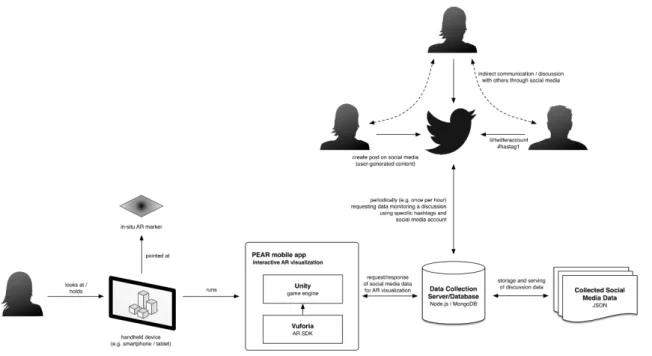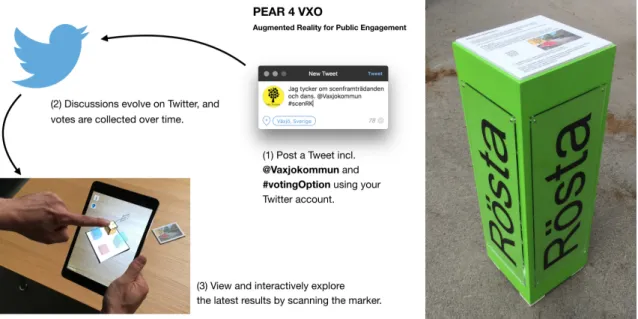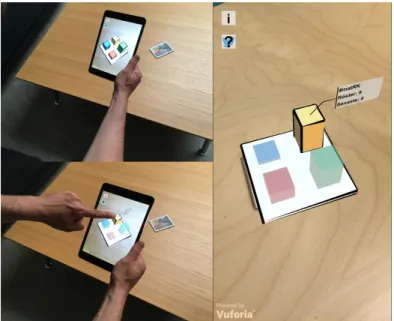PEAR 4 VXO: A case study using an Augmented Reality
framework to facilitate public engagement
Aris Alissandrakis and Nico Reski Department of Media Technology
Linnæus University, V¨axj¨o
{aris.alissandrakis,nico.reski}@.lnu.se
1
Introduction
Although the concept of Augmented Reality (AR) has been around for some years, particu-larly taking advantage of the availability of smartphone and tablet devices, it has not quite reached the mainstream1. However, the recent success of the mobile game Pokemon GO has considerably contributed to the public’s interest in mobile AR.
This paper presents our initial efforts towards a framework for facilitating public engage-ment through mobile AR, that fall under the overall project title “Augengage-mented Reality for Public Engagement” (PEAR).
Althoughboth Augmented and Virtual Reality technologies are becoming more accepted, their adoption for interdisciplinary purposes, especially in relation to the Humanities, is usually focused on the visual aspect (e.g. recreating a historical location, or digitising and displaying artefacts)2and thus not taking advantage of another very important aspect which is the possibility to interact with the virtual content.
We position our work in relation to the field of Digital Humanities as providing a frame-work that allows people to engage and interact in-situ with virtual content that can be the visualization of people’s consensus, but also an aggregation of multiple sources of data.
2
Concept and Interaction Design
The purpose of the PEAR framework is to visualize data from (and for) the public discussion about a certain issue, in an interactive and engaging way, thus creating additional value. It allows the public to both
• be informed (by viewing the visualization using the AR mobile app), and also
• participate in the discussion by using social networks, or by interacting with the AR visualization.3
The data visualization is continuously updated, based on the public interaction. More specifically, as users debate about a topic on social media networks, such as e.g. Twitter
1
Mainstream adoption for AR technologies is predicted within the next 5-10 years, see Gartner Hype Cycle for Emerging Technologies Report 2016 (http://www.gartner.com/newsroom/id/3412017).
2See for example the two projects
http://www.dukewired.org/projects/visualizing-venice and
https://augmentedpalimpsest.wordpress.com.
3Currently, only participation via social networks (Twitter) is implemented in the prototype. Direct
interaction with the AR visualization within the mobile app is a feature under development.
Figure 1: Overview of the PEAR architecture.
or Facebook, public data can be collected using certain keywords or hashtags. These data can be analysed and ranked (according to the frequency of different hashtags), and a visu-alization (representative of the current discussion) can be created. The data visuvisu-alization can be designed to additionally highlight any recent changes (between previous and current updates), providing further insights.
An essential part behind the idea of PEAR is the strategic placement of the AR marker (needed to show the visualization), ideally leading the user to a real-world location that is connected to the discussed topic, e.g. a place of interest, a historical site, a caf´e in town, etc. The encouragement of the user to physically move to the real-world location in order to observe (via the AR visualization) the latest updates about the discussion aims to facilitate the users engagement in the discussion as new thoughts, ideas or opinions may be formed through the visit of the site. It can be argued that users could obtain such information at home, online; however, they would be at a (both geographical and psychological) distance. Providing access to “live” information in-situ may encourage participation and involvement, and also allow them to reflect from a closer perspective.
The implemented prototype of the framework is divided into two parts: a data collection (server-side) part, and an interactive AR visualization (client-side) part (see Figure 1).
3
PEAR 4 VXO: A case study
In collaboration with the V¨axj¨o kommun, an implementation of the PEAR framework was deployed related to an ongoing public debate regarding the future development of the Rings-berg/Kristinebergs area in the city of V¨axj¨o, Sweden. The public was invited to vote about this issue by composing a tweet that included @vaxjokommun (the kommun’s Twitter ac-count) and specific hashtags, such as e.g. #parkRK or #matRK (indicating a preference to either develop a park or a restaurant/caf´e at the site).
Figure 2 (left) illustrates the overall workflow. Figure 2 (right) shows the deployed on-site stand. The top side of the stand, besides the AR marker, includes information about
Figure 2: Overall workflow of the deployed PEAR 4 VXO campaign (left), and photo of the on-site stand with info and AR marker (right).
the campaign (it invites the public to visit, download the AR app, scan the AR marker to view the latest results, as well as obtain overall impressions of the discussed area while they are there). Figure 3gives a visual impression of using the app.
The PEAR 4 VXO campaign ran from end of May to end of August 2016. There was a kickoff event during the “V˚arstad” town festival on May 28. The overall campaign was advertised in the April and May newsletters of the kommun. On May 26, two days before the kickoff, two news items4,5 were released by the kommun. An article in the local newspaper
about the V˚arstad festival mentioned the campaign. On June 7 there was an event related to the Digital Humanities initiative6, where the PEAR 4 VXO app and overall PEAR concept were presented. On June 17, there was a press release7 by Linnæus University (LNU). On
June 20, there was a post8 on the kommun’s Instagram account.
Although the campaign was advertised in a number of ways, the outreach and engage-ment with the public (in relation to the PEAR 4 VXO aspect) fell short of the expectations. A number of possible reasons for this are discussed below.
Although a version of the mobile app was also made for iOS devices, it could not be available online9 on the App Store in time for the campaign launch. As the market share of
iOS devices in Sweden is greater than for Android devices, this was a limitation.
Regarding the participation, it is possible that using Twitter was not familiar, at least for the V¨axj¨o public. Given the growing popularity of the social network in Sweden10 this
4 https://www.mynewsdesk.com/se/vaxjo_kommun/pressreleases/nu-kan-du-paaverka-utvecklingen-av-ringsberg-kristineberg-via-din-smartphone-1416605 5 https://monicaskagne.wordpress.com/2016/05/26/chans-att-paverka-hur-vill-du-att-ringsbergkristineberg-ska-utvecklas 6 https://lnu.se/en/research/searchresearch/digital-humanities 7 https://lnu.se/en/meet-linnaeus-university/current/news/2016/new-smartphone-app-aims-to-increase-public-engagement-in-local-issues 8 https://www.instagram.com/p/BG35Tf-oJy8/?hl=en 9
It was possible to install the app given physical access to an iOS device, but this was not a viable option for the general public.
10In Sweden, 22% of internet users use Twitter, see Svenskarna och internet 2015: En ˚arlig studie av
svenska folkets internetvanor (http://www.soi2015.se).
Figure 3: Photos from the prototype PEAR 4 VXO app in action.
hopefully will be less of an issue in the future.
Additionally, and perhaps more critically, although the campaign by the kommun men-tioned the existence of the mobile app, they did not provide direct links and information on how to download it, or shared the documents showing how to use Twitter to vote (as seen in Figure2, left). Besides the kickoff, two “bumps” in the activity happened around a) the Digital Humanities event (where a link to the Google Store was provided), and b) the press release by LNU (which again included this information) and the Instagram post (that possibly made people to visit the site, and interact with the stand/AR marker).
Nevertheless, there was at least a low level of user activity throughout the campaign, that visited the on-site marker in the Ringsberg/Kristinaberg area to check the latest voting results. Furthermore, the collected data and server logs point towards an overall successful technical implementation and deployment, as well as testing of both the server- and client-side parts of the PEAR framework, over the course of a three month campaign.
4
Conclusion
In this paper we introduced the PEAR framework, an approach of using mobile AR to facilitate public engagement in (online) debates and discussions. While there was a limited response and engagement from the public during the PEAR 4 VXO deployment, the results indicate a successful deployment and functionality – and thus serve as overall extended technical validation of the PEAR framework’s concept and implementation.
As these were initial efforts, more studies (deployments and data collections) need to be conducted in the future in order to address the potential facilitation of the public’s engagement using the PEAR framework. We also see potential in the extension of the implementation, including data visualization and collection from multiple sources at the same time, e.g. Twitter, Facebook, online databases, and sensors. Adapting, or rather extending, the architecture to additionally visualize sensor data in-situ is a future research direction.


